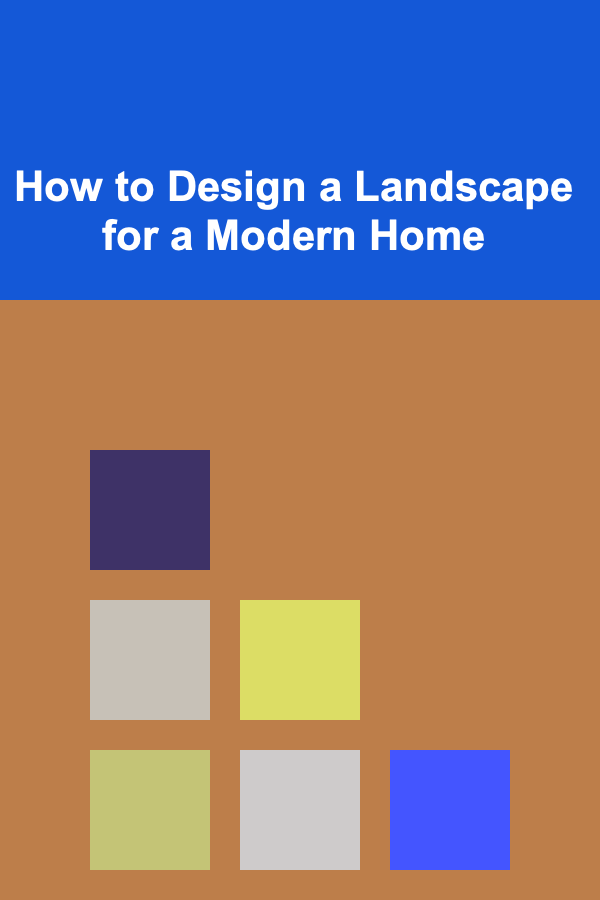
How to Design a Landscape for a Modern Home
ebook include PDF & Audio bundle (Micro Guide)
$12.99$11.99
Limited Time Offer! Order within the next:

Designing a landscape for a modern home is an intricate blend of art, architecture, and nature. It's not just about planting flowers and trees---it's about creating a space that complements the architecture, enhances the surrounding environment, and reflects the personality of the homeowner. The goal is to create an outdoor environment that seamlessly integrates with the modern home, providing both functional and aesthetic value. In this article, we'll explore how to design a landscape that not only suits a modern home's design but also creates an outdoor living space that invites relaxation, connection, and appreciation of nature.
The Principles of Modern Landscape Design
Modern landscape design is rooted in simplicity, functionality, and minimalism. This approach reflects the clean lines, geometric shapes, and uncluttered aesthetic commonly found in modern architecture. However, while simplicity is key, the landscape should also celebrate nature's diversity and beauty. Successful modern landscaping often balances several key principles:
- Simplicity: A modern landscape design prioritizes clean, geometric lines and uncluttered spaces. The layout should feel open and airy without being sparse or devoid of purpose.
- Integration with Architecture: The landscape should not only complement the architecture of the home but should feel like an extension of it. The design of the outdoor space should incorporate elements that echo the home's materials, shapes, and design philosophy.
- Functional Zones: A modern landscape should serve practical purposes. This could include creating different zones for socializing, relaxing, or entertaining. Every element in the landscape should have a clear function or purpose.
- Natural Materials: Modern landscaping often uses natural, durable materials like stone, wood, and metal to create a sense of connection to the earth. The use of these materials also supports sustainability and creates a timeless appeal.
- Minimalism: There's often a focus on the 'less is more' philosophy, where fewer, high-quality plants and materials are used to create a more refined and sophisticated atmosphere.
- Sustainability: A modern landscape often embraces eco-friendly design practices. This includes using drought-tolerant plants, sustainable water features, and energy-efficient lighting.
Designing for Functionality
1. Outdoor Living Spaces
An essential aspect of modern landscape design is the creation of functional outdoor living spaces. Modern homes typically feature open-plan layouts, and this should extend to the outdoors as well. An outdoor living space might include:
- Outdoor Kitchens: Many modern homeowners seek to bring the inside out, and an outdoor kitchen can be a central element of this. A modern outdoor kitchen often includes high-quality appliances, an integrated bar area, and plenty of counter space for preparing meals while enjoying the outdoors.
- Dining Areas: A dining space is essential for al fresco meals. A modern dining area should be both functional and stylish. Materials like concrete or natural wood provide a clean, minimal aesthetic while maintaining durability.
- Lounge Areas: Comfortable, stylish seating areas create spaces for socializing or quiet relaxation. Using furniture with clean lines and natural materials like wicker or teak can add to the modern feel while ensuring comfort.
- Fire Features: Fire pits, fireplaces, or fire tables are popular in modern landscaping. These elements can create a cozy atmosphere and serve as a focal point in the design.
- Outdoor Lighting: Proper lighting can elevate the look and functionality of an outdoor space. Using modern lighting techniques, such as low-voltage LED lights, can help highlight key features, enhance safety, and set the mood.
2. Pathways and Walkways
Pathways are a crucial part of any landscape design, offering both practical utility and aesthetic appeal. For a modern home, walkways should be sleek and minimal. Materials such as concrete, gravel, or stone can be used in geometric patterns to align with the home's modern aesthetic. Some design options include:
- Floating Pathways: Pathways that appear to float above the ground create an air of sophistication. These walkways are typically made with large, flat stones or concrete tiles spaced evenly to give the illusion of a floating design.
- Linear Pathways: Long, straight paths can guide visitors toward key areas of the landscape, like the front door, garden, or outdoor entertainment spaces.
- Curved Walkways: If the home's architecture incorporates curves or softer lines, a curved pathway may work better to create a harmonious flow.
3. Water Features
Water features add a sense of tranquility and movement to a modern landscape. Modern water features often incorporate sleek, minimalist designs that align with the overall aesthetic. Some examples include:
- Reflecting Pools: A reflecting pool, often designed with clean, straight edges, can mirror the home's architecture and surrounding environment. It can serve as a focal point in a front or backyard.
- Waterfalls and Fountains: Subtle, minimalist waterfalls or fountains can be integrated into garden walls, creating a soothing ambiance without overwhelming the design.
- Rain Gardens: A rain garden can collect and filter rainwater, contributing to sustainability while also serving as a natural feature in the landscape.
Plant Selection for a Modern Landscape
Choosing the right plants for a modern landscape is an important aspect of the design process. Modern landscaping tends to favor plants that are low-maintenance, drought-tolerant, and visually striking, focusing on clean lines and simple forms. Some important considerations include:
1. Geometric Shapes and Clean Lines
Plants with structured forms and clean lines are often favored in modern design. These plants create a sense of order and visual clarity. Some suitable plant types include:
- Grasses and Ferns: Ornamental grasses like fountain grass or blue fescue, as well as ferns, can add texture and movement to a space. Their linear, upright growth habits make them ideal for modern landscapes.
- Succulents and Cacti: These plants are perfect for modern, low-maintenance gardens. Their sculptural shapes and varied textures can create interest in an otherwise minimalist garden.
- Topiary: Topiary, the art of clipping plants into shapes or forms, is another modern landscaping trend. Topiary trees, especially in geometric shapes, add structure and style.
2. Minimalist Color Palette
Modern landscapes often stick to a restrained color palette, focusing on shades of green with pops of color from seasonal blooms or carefully chosen accents. Think monochromatic or complementary color schemes, where plantings do not overwhelm the space but instead provide subtle elegance.
- Neutral Greenery: Use plants with green foliage as the backdrop of the landscape. Plants with variegated or silver leaves can also add depth and visual interest.
- Pops of Color: For contrast, you may want to introduce plants that provide vibrant color at specific times of the year. Choose flowers that bloom in moderation, such as lavender, ornamental grasses, or bright perennials.
3. Native Plants and Sustainability
Sustainability is increasingly important in modern landscape design. Native plants are beneficial because they are adapted to the local climate, require less water, and tend to attract local wildlife. Using a mix of drought-resistant and native plants reduces the need for chemical fertilizers and pesticides while supporting biodiversity.
Outdoor Structures and Furniture
Adding functional and aesthetic structures to a modern landscape can help enhance the overall design. Structures like pergolas, trellises, and fences provide opportunities for architectural expression and help define different areas within the landscape.
- Pergolas and Gazebos: A modern pergola with clean lines can provide shade for outdoor spaces while adding a touch of elegance. Materials like steel, wood, or concrete can be used to create a structure that complements the home's architecture.
- Sculptural Elements: In keeping with the minimalist style of modern landscaping, incorporating sculptures or artistic installations can provide focal points for the design. These can be contemporary art pieces, sleek fountains, or even functional sculptures like outdoor seating.
Conclusion
Designing a landscape for a modern home is an exciting opportunity to blend art, architecture, and nature into a harmonious outdoor living space. By focusing on simplicity, functionality, and sustainability, you can create an outdoor environment that is both aesthetically pleasing and practical. From carefully chosen plants to carefully crafted outdoor spaces, modern landscape design is all about creating a seamless integration between the home and the natural world. Whether you're looking to create an outdoor kitchen, a tranquil retreat, or a minimalist garden, a thoughtfully designed landscape can elevate your modern home and offer an inviting escape from the indoors.
Reading More From Our Other Websites
- [Organization Tip 101] How to Maintain an Emergency Contact List for All Campers
- [Home Rental Property 101] How to Navigate Rental Property Laws and Regulations
- [Hiking with Kids Tip 101] Step-by-Step Guide: Helping Kids Overcome Height Anxiety While Exploring Nature
- [Home Pet Care 101] How to Keep Your Pet Healthy and Happy with Proper Home Care
- [Personal Investment 101] Using Deep Learning to Develop Automated Income Streams
- [Home Lighting 101] How to Use Lighting to Set the Tone for Your Home's Interior Design
- [Stamp Making Tip 101] Best Practices for Making Multi‑Color Stamps Using Layered Silicone Molds
- [Simple Life Tip 101] Best Low‑Maintenance Indoor Gardens for Apartment Dwellers Seeking Simplicity
- [Home Staging 101] How to Stage Your Home on a Budget Without Compromising Style
- [Personal Care Tips 101] How to Choose a Perfume for a Relaxing Evening

How to Build a Profitable Side Hustle with Deep Learning
Read More
How to Properly Clean and Maintain Your Gutters
Read More
How To Incorporate Functional Medicine Principles
Read More
How To Develop a Powerful Evening Routine
Read More
How to Edit Real Estate Photos to Sell Homes
Read More
10 Tips for Using a Marketing Planner to Manage Content
Read MoreOther Products

How to Build a Profitable Side Hustle with Deep Learning
Read More
How to Properly Clean and Maintain Your Gutters
Read More
How To Incorporate Functional Medicine Principles
Read More
How To Develop a Powerful Evening Routine
Read More
How to Edit Real Estate Photos to Sell Homes
Read More